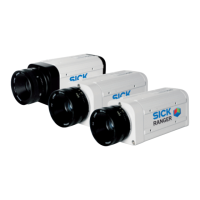Reference Manual Chapter 3
Ranger E/D
©SICK AG • Advanced Industrial Sensors • www.sick.com • All rights reserved 23
Mounting Rangers and Lightings
As a rule of thumb, the height resolution increases with the angle between the Ranger and
the laser, but the resolution is also depending on the angle between the Ranger and the
height direction (z axis).
The following formulas can be used for approximating the resolution for the different
geometries, in for example mm/pixel:
Geometry Approximate range resolution
Ordinary ∆Z ≈ ∆X / tan(β)
Reversed ordinary ∆Z ≈ ∆X / sin(α)
Specular ∆Z ≈ ∆X · cos(β) / sin(α+ β)
If α = β: ∆Z ≈ ∆X / 2 · sin(α)
Look-away ∆Z ≈ ∆X · cos(β) / sin( |α–β|)
where:
∆Z = Height resolution (mm/pixel)
∆X = Width resolution (mm/pixel)
α = Angle between Ranger and vertical axis (see figure 3.6)
β = Angle between laser and vertical axis (see figure 3.6)
Note that these approximations give the resolution for whole pixels. If the measurement is
made with sub-pixel resolution, the resolution in the measurement is the approximated
resolution divided by the sub-pixel factor. For example, if the measurement is made with
the Hi3D component that has a resolution of 1/16
th
pixel, the approximate resolution is
∆Z/16.
3.2 Intensity and Scatter Measurements
For other types of measurements than range, a general recommendation is to align the
light with the Ranger’s optical axis (as in figure 1.7 on page 26), or mount the lighting so
that the light intersects the optical axis at the lens’ entrance pupil. By doing so, the light
will always be registered by the same rows on the sensor, regardless of the height of the
object, and triangulation effects can be avoided.
An exception is when gloss is going to be measured, since this type of measurement
requires a specular geometry and usually a large angle. However, the triangulation effect is
heavy if the objects vary in height. Therefore it is difficult – if not impossible – to measure
gloss on objects that has large height variations.
3.3 MultiScan
When measuring with MultiScan, it is important to separate the light sources, so that the
light used for illuminating one part of the sensor does not disturb the measurements made
on other parts of the sensor.
If separating the light sources is difficult, the measurements may be improved by only
measuring light with specific wavelengths, using filters and colored (or IR) lightings.
For example, an IR band pass filter can be mounted so that it covers a part of the sensor,
and an IR laser can be used for illuminating the object in that part. This way, range can be
measured in the IR filtered part of the sensor, and at the same time intensity can be
measured in the non-filtered area using white light, without disturbing the range meas-
urements.
For certain Ranger models, a built-in IR filter is available as an option. The IR filter is
mounted so that rows with low row numbers are unaffected by the filter (0–10 for Ranger,
0–16 for ColorRanger), and rows 100–511 are filtered. Please refer to “Ranger E and D
Models” on page 113 for a list of available models.

